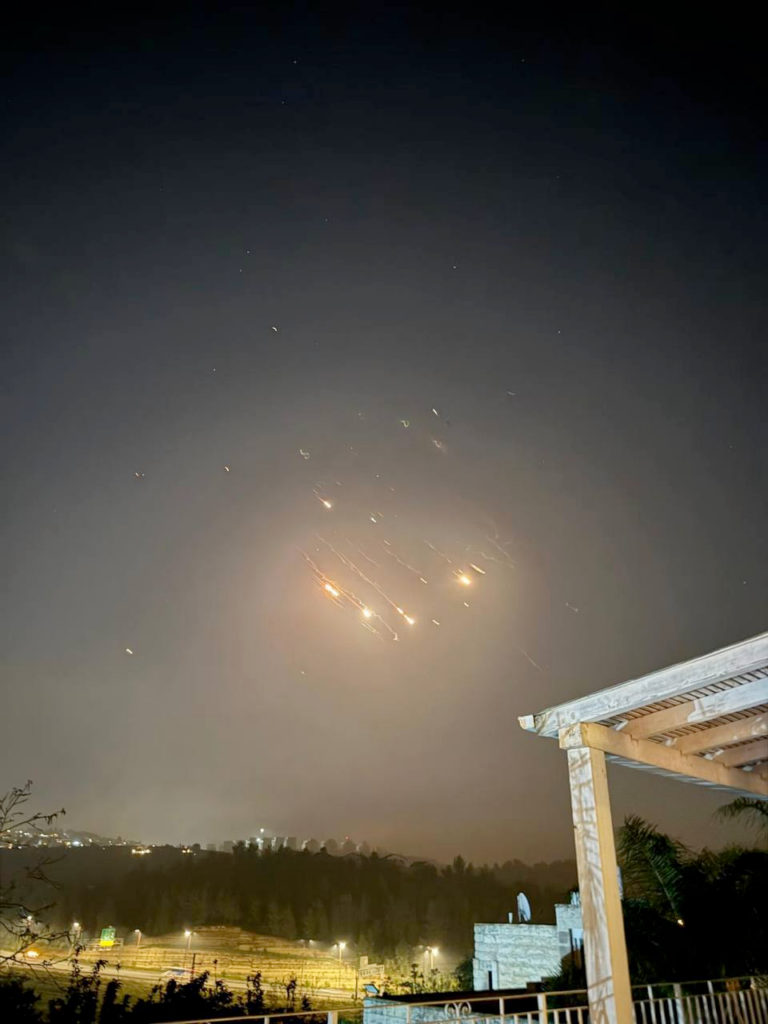A waking call: Israel under fire

Malte Ian Lauterbach reports on the recent Iranian rocket attacks on Israel, how they came about, and what will happen next. When the Israeli Air Force attacked the Iranian embassy in Damascus at the beginning of the month, killing seven senior members of the Iranian Revolutionary Guards, including two generals, and six Syrians, it was already clear that this attack would not go unanswered by Iran. (BSN reported here)
At around 9 p.m. local German time, the next chapter unfolded amidst escalating violence in the Middle East, as the airspace of Jordan, Iraq, Iran, Lebanon, Syria, and Israel (with the Arab states following later) was closed in one fell swoop. Minutes later, more than 170 Shahed-136 and Shahed-131 ‚Mopeds‘, known for the characteristic sound of their engines, took off in Iranian and Iraqi airspace. The long range of the Shaheds enables them to reach any city in Israel. However, this swarm of drones has a different task – to overwhelm the Israeli air defense, allowing other projectiles such as Iranian cruise missiles or ballistic medium-range rockets to reach their targets.
The ‚Mopeds‘ fly neither particularly fast nor particularly inconspicuously, so they are frequently intercepted by machine guns on jeeps in Ukraine. During the nearly 6-hour flight time, most of them are intercepted by the American and Israeli air forces over Syria and Jordan. Remarkably, Jordan allowed the air forces (Britain, USA, Israel) to use Jordanian airspace to intercept the drones. The Jordanian Air Force also participated in the air defense.

While the ‚Shaheds‘ continue to roar over Iraq towards Israel, a series of cruise missiles are launched in Iran – presumably of the ‚Paveh‘ or ‚Hoveyzeh‘ type. Known for their range and extreme precision, these are used to attack precision targets. Over the airspace of Israel’s neighboring states, fighter jets are engaged in a mission they have been training for decades. A training that now turns into reality. Of the 36 guided missiles launched from Iranian airspace, 25 are intercepted by the Israeli Air Force before reaching Israeli airspace. The remainder is intercepted by air defense and other air forces. None of them reach their target.

At the same time, more than 120 ballistic medium- and long-range missiles are launched in Iranian airspace – many of them of the ‚Ghadr-110‘ type, a ballistic medium-range missile that sacrifices precise accuracy for its enormous speed of over nine times the speed of sound. Here, too, the Israeli air defense system ‚Arrow‘ intercepts the majority of the missiles, many of them also over Jordanian airspace and in outer space. A „low single-digit number“ of missiles hit an Israeli Air Force base in the Negev, which was used by Israeli F-35I jets to attack the embassy in Damascus.
The exact extent of the damage is still unclear, but senior officials of the Israeli military speak of ‚minor damage to military infrastructure‘. The preliminary end result – 185 drones, 36 cruise missiles, more than 110 ballistic missiles shot down. Tensions between Iran and Israel have reached a new chapter. For years, both sides have been involved in a shadow war, primarily playing out on the internet. Israel accuses Iran of being directly involved in planning the massacre on October 7th, a accusation that does not seem unrealistic, especially given the large number of Iranian weapons and documents in the possession of Hamas.
According to American Defense Department officials, Iran serves as a coordinator between Hamas, Hezbollah, and Ansar Allah al-Huthi (the Houthi rebels). Since October 7th, Israel and Iran have been increasingly on a collision course. Most attacks on ships in the Red Sea are based on Iranian reconnaissance ships, carried out under Iranian supervision with Iranian sea-to-surface missiles from Yemen. Iran calls the rocket attacks on Israel ‚Operation True Promise‘. It is indeed a true promise to the Iranian population – where thousands gathered in the cities to show their support for the attack on Israel.
But it is also a promise to Iran’s allies – Hezbollah, Hamas, the Houthi rebels, and the militias in Iraq, who have been embroiled in a war with Israel for months, manipulated by Iran as pawns but seeing little support from Iran itself. But it is also a promise to Israel that it would respond to attacks on Iranian soil (like the embassy) quid pro quo. In addition, Iran signals clearly to the United Nations that they have no interest in further escalation of the situation, and they consider the confrontation to be over for them – but at the same time threatens Israel with further massive attacks.
An erupting conflict involving the two most powerful states in the Middle East would force hundreds of thousands to flee and likely claim as many lives. Iran has one of the most modern and advanced arsenals in the Middle East, from cruise missiles to intercontinental missiles with independently targetable multiple re-entry vehicles (MIRV). It cannot be ruled out that Iran now possesses nuclear weapons with North Korean help. The enormous distance between Israel and Iran complicates an Israeli response – even the Israeli F-35I only reaches Iran through multiple aerial refuelings, which is difficult to manage over hostile Iraqi airspace.
As so often in the history of the Middle East, the future depends on how Israel responds to the attacks. Thus, Israel and the Middle East face a decisive challenge. The question arises of how the Israeli government should respond to the attacks without further destabilizing the region and triggering a comprehensive war. Conceivable would be a symbolic attack on comparable military infrastructure in Iran, similar to the Iranian attack on the airbase in Israel. In Washington, it is said that Israel’s response to the Iranian air strikes would not be supported. It is completely unclear whether the spiral of violence will continue.

